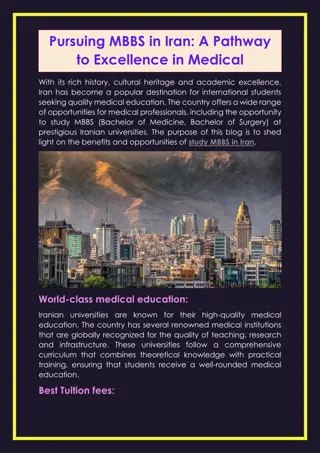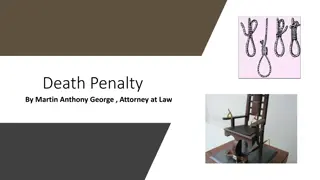The Death Penalty and Vulnerable Minorities in Iran: Challenges and Recommendations
Iran is a diverse country with multiple ethnic and religious groups, yet power is predominantly held by the Persian-Shiite group. Minorities like Kurds, Ahwazi-Arabs, Azerbaijanis, Baluchis, and Turkmens face discrimination and challenges, including repression and unemployment. The Iranian Constitution is discriminatory, favoring the official religion and language, leading to inequalities in representation and rights for minorities. There is a lack of accurate statistical data on these minority groups, hindering efforts to address their issues. Recommendations are needed to address the death penalty and improve conditions for vulnerable groups in Iran.
Download Presentation

Please find below an Image/Link to download the presentation.
The content on the website is provided AS IS for your information and personal use only. It may not be sold, licensed, or shared on other websites without obtaining consent from the author. Download presentation by click this link. If you encounter any issues during the download, it is possible that the publisher has removed the file from their server.
E N D
Presentation Transcript
The Death Penalty and the Vulnerable Groups in Iran/Kurdish Case DEATH PENALTY IN IRAN: RECOMMANDATIONS AHEAD OF THE 3RD UPR OF IRAN/Taimoor Aliassi/KMMK-G/ HRC-Geneva/ September 12th, 2019
WHO ARE IRANS MINORITIES? Iran is a multi-ethnic and multi-religious country with a population of 80 million people composed mainly of Persians, Kurds, Baluchis, Azerbaijanis, Turkmens and Ahwazi-Arabs. The official language is Persian and the main religion is Shi'a Islam - strongly dominated by the Twelver Ja'fari School. Despite the importance of the ethnic constituents of Iran, only the Persian-Shiite group holds state power. 2
Statistics on ethnic & religious Groups in Iran Since 2005, despite multiple demands from various UN Treaty Body committees, in particular the Committee on the Elimination of Racial Discrimination (CERD), Iran refuses to provide appropriate and accurate statistical data about members of ethnic and religious groups in the country. The UN SR, in his latest report, he provides some estimated statistics on Iran s ethnic & religious groups but the Iranian government refused these data and it also refused to offer alternative figures . Iran s ethnic estimative figures: Kurds: 11-13 millions: 66% Sunni, 27% Shia, others are Yarasan, Christians & Jews Main challenges: repression, discrimination (Gozinesh), landmine, environmental crisis, unemployment, blind-killing of kolbaran (border courriers) Ahwazi-Arabs: 3-5 millions: 70% Shi a Muslims and 30% Sunni Muslims Main challenges: repression, discrimination (Gozinesh), landmine, environmental crisis, unemployment Azerbaijani Turks: 15-17 millions: Shi a Muslims Main challenges: Azerbaijanis are facing severe discrimination and deprivation of language and cultural rights Baluchis: 5-7 millions: Sunni Muslims Main challenges: statelessness, repression, discrimination (Gozinesh), unemployment, Turkmens: 3-5 millions: Sunni Muslims Main challenges: , unemployment, discrimination (Gozinesh), The Kurdish people in Iran amount to 13% of Iran s 80 million however their share of execution is over 25% in 2018 3
Irans Constitution Iran s constitution is discriminative and anti minority and anti women: Article 19 of the Constitution of the Islamic Republic, All people of Iran, whatever the ethnic group or tribe to which they belong, enjoy equal rights; and color, race, language, and the like, do not bestow any privilege. But article 1, 4 and 12 state that : the official religion of the country is the 12th Imam Shiasm (ShiayeEsnaAshari), all laws must be based on this branch of shia and only persian (Article 15) is the official language. So, in practice, a Kurd, a Baluchi, an Arab, a Bahai are deprived from any significant posts. 4
Irans Constitution Article 48 of the Constitution also states that, There must be no discrimination among the various provinces with regard to the exploitation of natural resources, utilization of public revenues, and distribution of economic activities among the various provinces and regions of the country, thereby ensuring that every region has access to the necessary capital and facilities in accordance with its needs and capacity for growth. But Article 115 apply the gozinesh or selective practice to marginalizing minorities by expressly denying them employment in the State sector, as well as in parts of the Private sector. There is no Kurdish governor in Kurdistan 5
Irans International Law Obligations Iran has ratified 5 of 9 international conventions: The International Covenant on Civil and Political Rights (ICCPR); The International Covenant on Economic, Social and Cultural Rights (ICESCR); The Convention on the Rights of the Child ( CRC); The Convention on the Rights of Persons with Disabilities; and The International Convention on the Elimination of All Forms of Racial Discrimination. 6
Political prisoners Report of the Special Rapporteur on the situation of human rights in the Islamic Republic of Iran, published on August 16th, 2019: Kurdish political prisoners charged with national security offences represent almost half of the total number of political prisoners in the Islamic Republic of Iran and constitute a disproportionately high number of those who received the death penalty and are executed , UNSR: In 2018, 828 Kurdish citizens were arrested, many of whom were sentenced to long years of imprisonment and were charged with crimes relating to civic activism and membership in Kurdish political parties.
Political prisoners/From January to August 31st 2019, 352 Kurdish citizens were arrested and imprisonment/Motives: Civic activism & memebrships of Kurdish political parties 100 of them sentenced to 86 Cooperations with Kurdish politicla parties, 10 Participation in Newroz-Kurdish New Year celebrations, 1 Participation in May 1st Ceremony, Worker day, 7 Participation in gatherings against Violences Against women, 9 Wearing Kurdish cloths and holding Kurdistan flag, 7 Kolbaran, 2 membershipm of National Unity Party (Wahdat Mili), 1 membership of the Group 14, 4 Propaganda against the regime, 5 participation in teahcers general strike, 1 Rising Kurdistan flag, 3 not wearing veil adequately (Bad Hijabi) 8
Cases of Ms. Zara Mohammadi, imprisonned for teaching Kurdish language Titre Arial 20
Mohammad Nazari, over 26 years in prison for membership of a Kurdish political party 10
Executions UNSR: Kurdish political prisoners constitute a disproportionately high number of those who received the death penalty and are executed in Iran. Over a quarter of prisoners put to death penalty in 2018 in Iran were Kurds according to our data. Last September, despite the UN special rapporteur s warning, Iran executed Lukman, Zanyar Moradi and Ramin Panahi for their political opinions. It is also important to highlight that nearly a quarter (17 out of 73) of the executions of Kurdish prisoners took place outside Kurdish regions and the number of executions related to belief and political opinion were 10 in 2017 while this number is 29 in 2018. 11
Executions One year after the execution of Lukman, Zanyar and Ramin, the government refuses to return back the bodies of the victims to their families. The parents of Ramin are awaiting to burry the body of their son 12
Extra-Judicial Executions of Kurdish Citizens Raising While the number of executions is reducing in Iran, on the contryry the number of extra-judicial killings of Kurdish citizens are raising dramatically. Since, January 2019, 168 Kurdish Kolbar/border couriers were targeted by Iranian security forces: 125 killed by direct shootings In 2018, 225 victims were reported according to the UNSR for Iran In 2017: 152 cases In 2016: 122 cases Mr. YunisALTUN son of Omar, a 26 yeas old Kurdish Kolbar, from Nimanche village of Piranshahr, was killed by IRGC forces on 4th July 2019 in Ziwya & Mashkan border region. 13
Thank your for your attention I m at your diposition to answer your questions Taimoor.aliassi@gmail.com www.kmmk-ge.org 076 366 23 58 15























